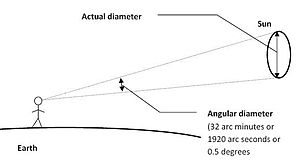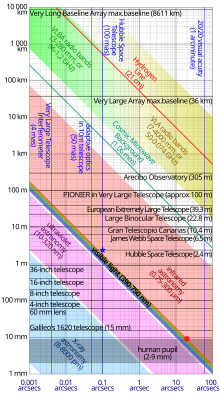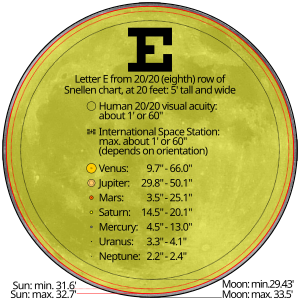How To Find Angular Size
The angular diameter, angular size, apparent diameter, or apparent size is an angular distance describing how big a sphere or circle appears from a given indicate of view. In the vision sciences, it is called the visual bending, and in optics, information technology is the angular aperture (of a lens). The angular diameter can alternatively be thought of as the angular displacement through which an eye or photographic camera must rotate to look from one side of an apparent circumvolve to the opposite side. Humans can resolve with their naked eyes diameters of up to about i arcminute (approximately 0.017° or 0.0003 radians).[1] This corresponds to 0.three k at a 1 km distance, or to perceiving Venus as a disk nether optimal weather.
Formula [edit]

Diagram for the formula of the athwart diameter
The athwart diameter of a circle whose airplane is perpendicular to the deportation vector between the bespeak of view and the middle of said circle can be calculated using the formula[2]
in which is the angular diameter, and is the actual bore of the object, and is the distance to the object. When , nosotros have , and the issue obtained is in radians.
For a spherical object whose actual bore equals and where is the altitude to the center of the sphere, the angular diameter tin can be constitute by the formula
The difference is due to the fact that the credible edges of a sphere are its tangent points, which are closer to the observer than the center of the sphere. The difference is meaning only for spherical objects of big angular diameter, since the following modest-angle approximations hold for pocket-size values of :[3]
Estimating angular bore using the paw [edit]

Approximate angles of 10°, xx°, 5°, and one° for the hand outstretched arm'southward length.
Estimates of athwart diameter may exist obtained by holding the hand at correct angles to a fully extended arm, equally shown in the figure.[4] [five] [6]
Utilise in astronomy [edit]

Angular diameter: the angle subtended by an object
In astronomy, the sizes of celestial objects are often given in terms of their angular diameter equally seen from Earth, rather than their actual sizes. Since these angular diameters are typically small, information technology is common to present them in arcseconds (″). An arcsecond is 1/3600th of i caste (i°) and a radian is 180/π degrees. So one radian equals three,600 × 180/ arcseconds, which is about 206,265 arcseconds (1 rad ≈ 206,264.806247"). Therefore, the angular diameter of an object with physical diameter d at a distance D, expressed in arcseconds, is given by:[seven]
- .
These objects have an angular diameter of 1″:
- an object of bore ane cm at a altitude of 2.06 km
- an object of diameter 725.27 km at a altitude of 1 astronomical unit (AU)
- an object of diameter 45 866 916 km at 1 light-twelvemonth
- an object of diameter 1 AU (149 597 871 km) at a distance of 1 parsec (pc)
Thus, the athwart diameter of World's orbit around the Sun every bit viewed from a altitude of 1 pc is 2″, as one AU is the mean radius of Globe'due south orbit.
The athwart diameter of the Sun, from a distance of one light-twelvemonth, is 0.03″, and that of Earth 0.0003″. The angular diameter 0.03″ of the Sunday given above is approximately the same as that of a human being body at a distance of the diameter of Earth.
This tabular array shows the athwart sizes of noteworthy angelic bodies every bit seen from Globe:
| Celestial object | Angular diameter or size | Relative size |
|---|---|---|
| Magellanic Stream | over 100° | |
| Gum Nebula | 36° | |
| Milky Way | 30° (by 360°) | |
| Width of spread out hand with arm streched out | twenty° | 353 meter at i km altitude |
| Serpens-Aquila Rift | twenty° past 10° | |
| Canis Major Overdensity | 12° by 12° | |
| Smith's Cloud | 11° | |
| Large Magellanic Deject | ten.75° by ix.17° | Notation: brightest milky way, than the Galaxy, in the nighttime sky (0.ix apparent magnitude (V)) |
| Barnard'due south loop | 10° | |
| Zeta Ophiuchi Sh2-27 nebula | x° | |
| Width of fist with arm streched out | 10° | 175 meter at 1 km distance |
| Sagittarius Dwarf Spheroidal Milky way | seven.5° by 3.6° | |
| Coalsack nebula | 7° past 5° | |
| Rho Ophiuchi cloud complex | four.5° by 6.v° | |
| Hyades | five°thirty′ | Note: brightest star cluster in the night sky, 0.v credible magnitude (V) |
| Small Magellanic Cloud | 5°20′ by 3°5′ | |
| Andromeda Galaxy | 3°10′ past i° | Nearly six times the size of the Sunday or the Moon. Only the much smaller core is visible without long-exposure photography. |
| Veil Nebula | iii° | |
| Heart Nebula | 2.5° by two.five° | |
| Westerhout 5 | 2.3° by 1.25° | |
| Sh2-54 | 2.3° | |
| Carina Nebula | 2° by 2° | Notation: brightest nebula in the nighttime sky, 1.0 credible magnitude (V) |
| North America Nebula | 2° by 100′ | |
| Orion Nebula | ane°5′ by 1° | |
| Width of pinkie with arm streched out | 1° | 17.5 meter at 1 km altitude |
| Moon | 34′6″ – 29′20″ | 32.5–28 times the maximum value for Venus (orangish bar beneath) / 2046–1760″ the Moon has a diameter of three,474 km |
| Lord's day | 32′32″ – 31′27″ | 31–30 times the maximum value for Venus (orange bar beneath) / 1952–1887″ the Sun has a diameter of ane,391,400 km |
| Helix Nebula | well-nigh sixteen′ past 28′ | |
| Spire in Eagle Nebula | 4′40″ | length is 280″ |
| Venus | i′six″ – 0′nine.vii″ | |
| International Space Station (ISS) | 1′3″ | ;[8] the ISS has a width of about 108 one thousand |
| Maximum resolvable diameter by the human eye | ane′ | ;[9] 0.three meter at 1 km distance[x] |
| Virtually 100 km on the surface of the Moon | 1′ | Comparable to the size of features like large lunar craters, such as the Copernicus crater, a prominent brilliant spot in the eastern part of Oceanus Procellarum on the waning side, or the Tycho crater inside a bright area in the south, of the lunar near side. |
| Jupiter | 50.1″ – 29.8″ | |
| Maximum resolvable signal/gap past the homo eye | xl″ | ;[nine] at close view the width of a 0.04 mm very thin hair[10] |
| Mars | 25.1″ – iii.5″ | |
| Saturn | twenty.1″ – 14.five″ | |
| Mercury | xiii.0″ – 4.5″ | |
| Uranus | iv.ane″ – 3.three″ | |
| Neptune | 2.4″ – 2.2″ | |
| Ganymede | 1.8″ – 1.2″ | Ganymede has a diameter of v,268 km |
| An astronaut (~1.seven thou) at a distance of 350 km, the boilerplate distance of the ISS | ane″ | |
| Maximum resolvable diameter by Galileo Galilei'south largest 38mm refracting telescopes | ~1″ | ;[11] Note: 30x[12] magnification, comparable to very strong gimmicky terrestrial binoculars |
| Ceres | 0.84″ – 0.33″ | |
| Vesta | 0.64″ – 0.twenty″ | |
| Pluto | 0.xi″ – 0.06″ | |
| Eris | 0.089″ – 0.034″ | |
| R Doradus | 0.062″ – 0.052″ | Notation: R Doradus is idea to be the extrasolar star with the largest apparent size equally viewed from Earth |
| Betelgeuse | 0.060″ – 0.049″ | |
| Alphard | 0.00909″ | |
| Alpha Centauri A | 0.007″ | |
| Canopus | 0.006″ | |
| Sirius | 0.005936″ | |
| Altair | 0.003″ | |
| Deneb | 0.002″ | |
| Proxima Centauri | 0.001″ | |
| Alnitak | 0.0005″ | |
| Proxima Centauri b | 0.00008″ | |
| Issue horizon of black hole M87* at center of the M87 galaxy, imaged past the Event Horizon Telescope in 2019. | 0.000025″ ( 2.5×x−v ) | Comparable to a lawn tennis brawl on the Moon |
| A star like Alnitak at a distance where the Hubble Space Telescope would just be able to come across it[13] | 6×ten−10 arcsec |

Log-log plot of aperture diameter vs angular resolution at the diffraction limit for various light wavelengths compared with diverse astronomical instruments. For example, the blue star shows that the Hubble Space Telescope is almost diffraction-limited in the visible spectrum at 0.1 arcsecs, whereas the ruddy circle shows that the human heart should have a resolving power of 20 arcsecs in theory, though commonly only 60 arcsecs.

Comparison of angular diameter of the Sunday, Moon and planets. To get a truthful representation of the sizes, view the prototype at a distance of 103 times the width of the "Moon: max." circle. For instance, if this circumvolve is five cm wide on your monitor, view it from v.fifteen chiliad away.

The table shows that the angular diameter of Lord's day, when seen from Earth is approximately 32′ (1920″ or 0.53°), every bit illustrated above.
Thus the angular diameter of the Dominicus is about 250,000 times that of Sirius. (Sirius has twice the bore and its distance is 500,000 times as much; the Sun is x10 times as bright, corresponding to an angular diameter ratio of xfive, so Sirius is roughly 6 times as brilliant per unit of measurement solid angle.)
The angular diameter of the Sun is also about 250,000 times that of Alpha Centauri A (it has almost the same bore and the distance is 250,000 times as much; the Sun is 4×1010 times equally bright, corresponding to an angular bore ratio of 200,000, and then Alpha Centauri A is a trivial brighter per unit solid angle).
The angular diameter of the Sun is near the same as that of the Moon. (The Sun's diameter is 400 times as big and its altitude also; the Dominicus is 200,000 to 500,000 times every bit bright as the full Moon (figures vary), respective to an angular bore ratio of 450 to 700, so a angelic body with a diameter of 2.5–4″ and the aforementioned effulgence per unit solid bending would have the aforementioned brightness every bit the total Moon.)
Even though Pluto is physically larger than Ceres, when viewed from Globe (e.g., through the Hubble Space Telescope) Ceres has a much larger credible size.
Athwart sizes measured in degrees are useful for larger patches of sky. (For instance, the three stars of the Chugalug cover about 4.5° of angular size.) However, much finer units are needed to measure the athwart sizes of galaxies, nebulae, or other objects of the night sky.
Degrees, therefore, are subdivided every bit follows:
- 360 degrees (°) in a total circle
- 60 arc-minutes (′) in one degree
- threescore arc-seconds (″) in ane arc-infinitesimal
To put this in perspective, the full Moon as viewed from Earth is about i⁄2 °, or thirty′ (or 1800″). The Moon'due south movement beyond the sky can exist measured in angular size: approximately 15° every hour, or 15″ per 2nd. A one-mile-long line painted on the confront of the Moon would appear from Globe to exist about ane″ in length.

Minimum, mean and maximum distances of the Moon from Earth with its angular diameter as seen from Globe'southward surface, to scale
In astronomy, it is typically difficult to direct measure the altitude to an object, yet the object may have a known physical size (peradventure information technology is like to a closer object with known altitude) and a measurable angular diameter. In that case, the athwart bore formula can be inverted to yield the angular diameter distance to distant objects as
In non-Euclidean space, such every bit our expanding universe, the angular diameter altitude is only one of several definitions of distance, so that in that location tin can exist dissimilar "distances" to the same object. See Distance measures (cosmology).
Non-circular objects [edit]
Many deep-sky objects such every bit galaxies and nebulae appear non-round and are thus typically given 2 measures of diameter: major centrality and modest axis. For example, the Small-scale Magellanic Cloud has a visual apparent diameter of 5° xx′ × 3° 5′.
Defect of illumination [edit]
Defect of illumination is the maximum angular width of the unilluminated part of a celestial body seen by a given observer. For example, if an object is 40″ of arc across and is 75% illuminated, the defect of illumination is 10″.
Encounter also [edit]
- Angular diameter distance
- Angular resolution
- Solid angle
- Visual acuity
- Visual angle
- Visual Angle Illusion
- Listing of stars with resolved images
- Apparent magnitude
References [edit]
- ^ Yanoff, Myron; Duker, Jay S. (2009). Ophthalmology 3rd Edition. MOSBY Elsevier. p. 54. ISBN978-0444511416.
- ^ This can be derived using the formula for the length of a string found at "Circular Segment". Archived from the original on 2014-12-21. Retrieved 2015-01-23 .
- ^ "A Taylor serial for the functionarctan" (PDF). Archived from the original (PDF) on 2015-02-eighteen. Retrieved 2015-01-23 .
- ^ "Coordinate Systems". Archived from the original on 2015-01-21. Retrieved 2015-01-21 .
- ^ "Photographing Satellites". 8 June 2013. Archived from the original on 21 January 2015.
- ^ Wikiversity: Physics and Astronomy Labs/Angular size
- ^ Michael A. Seeds; Dana E. Backman (2010). Stars and Galaxies (vii ed.). Brooks Cole. p. 39. ISBN978-0-538-73317-v.
- ^ "Problem 346: The International Space Station and a Sunspot: Exploring angular scales" (PDF). Space Math @ NASA !. 2018-08-19. Retrieved 2022-05-twenty .
- ^ a b Wong, Yan (2016-01-24). "How small can the naked eye see?". BBC Science Focus Magazine . Retrieved 2022-05-23 .
- ^ a b "Sharp eyes: how well tin we really see?". Science in School – scienceinschool.org. 2016-09-07. Retrieved 2022-05-23 .
- ^ Graney, Christopher M. (Dec 10, 2006). "The Accurateness of Galileo'south Observations and the Early Search for Stellar Parallax". arXiv.org. doi:ten.1007/3-540-50906-2_2. Retrieved May 21, 2022.
- ^ "Galileo's telescope - How it works". Esposizioni on-line - Istituto eastward Museo di Storia della Scienza (in Italian). Retrieved May 21, 2022.
- ^ 800 000 times smaller angular bore than that of Alnitak as seen from Earth. Alnitak is a blue star and then it gives off a lot of light for its size. If it were 800 000 times further away and then it would exist magnitude 31.five, at the limit of what Hubble can see.
External links [edit]
- Small-Angle Formula
- Visual Assistance to the Apparent Size of the Planets
How To Find Angular Size,
Source: https://en.wikipedia.org/wiki/Angular_diameter
Posted by: marquezgraime.blogspot.com















0 Response to "How To Find Angular Size"
Post a Comment